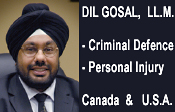LawyersWorld.org Better to Get Busted in Canada or the USA when Trafficking in Illegal Drugs? Principles of Sentencing in Canadian and U.S. Federal Criminal Law as applied to Drug Offences. Article by By Dil Gosal, BA, J.D., LL.M., Attorney At Law, Washington State USA & BC, Canada, Criminal Defense Lawyer
Differences between USA Criminal Court Sentences vs Canada Court Sentences for similar criminal code convictions e.g. drug trafficking: Principles of sentencing in Canadian Law versus U.S. Federal Criminal Law , as applied to Drug Offences
Organized Criminal Gangs & Canada-US Cross Border Drug Trafficking/Smuggling: The Bacon Brothers, BC Bud - Marijuana Grow Ops, Hells Angels, Red Scorpions, Independent Soldiers, UN Gang: Quite the colorful collage of names we have here on the West Coast. There has recently been a lot of news
coverage regarding the disparity between the length of sentences received
in Canada and the USA for people convicted of similar drug offences. Statutory Scheme & Offences CANADAIn Canada, Crown attorneys prosecute
drugs like marijuana and cocaine, not under the Criminal Code, RSC,
but a separate Act of Parliament, called the Controlled Drugs and
Substances Act, SC, 1996 ('CDSA'). This replaced the
Narcotics Control Act. POSSESSION CHARGES & PUNISHMENT4(1) of the CDSA prohibits the Possession of substances found in Schedule I, II, and III. For Schedule I offences: If the Crown elects to proceed by way
of Indictment (akin to Felony Prosecution), the maximum term of imprisonment
is 7 years. (4)(3)(a), CDSA. If the Crown elects to proceed by Indictment,
a term not exceeding 5 years less a day; and upon Summary prosecution,
a maximum fine of $1,000 and/or up to 6 months imprisonment. Subsequent
Summary offences allow for up to $2,000 in fines, and/or up to 1 year
in jail. See(4)(4)(b)(i)-(ii). TRAFFICKING IN SUBSTANCE, or POSSESSION FOR PURPOSE OF TRAFFICKINGSection 5 of the CDSA prohibits trafficking or Possession for the Purposes of Trafficking in Schedule I, II, III or IV drugs or substances. Section 5(3) provides a maximum penalty of Life Imprisonment for where one trafficks or possession for the purposes of trafficking, Schedule I or II offences. 5.(3)(a) CDSA. For Trafficking or Possession for the
Purposes of Trafficking Schedule III drugs or substances, a maximum
of 10 years upon Indictment, or maximum 18 months for Summary Prosecution.
5.(3)(b) CDSA. IMPORTING/EXPORTING or POSSESSION FOR PURPOSES OF IMPORTING/EXPORTING
Section 6 deals with Importing and Exporting of Scheduled drugs and
substances. PRODUCTIONSection 7 of the CDSA deals with the Production of the drugs or substances. For Production, other than cannabis (marijuana), the maximum term is Life Imprisonment. Where the subject-matter is cannabis (marijuana) the maximum term is 7 years. Judicial Discretion to fashion Sentence. US-STYLE SENTENCING COMES TO CANADA: NO MORE HOUSE-ARREST FOR DRUG CONVICTIONS
The availability, under s.742 of the Criminal Code, of the Conditional
Sentence Order (CSO) - where the offender serves his jail term of less
than 2 years in the community, usually with conditions of Supervision,
Curfew, house-arrest, electronic home monitoring, will no longer
be available for MMS offences. This is a material change for many
who take care of Marijuana grow operations, or involved in the sale
of Drugs, such as Dial-a-Dopers. There are also enumerated "serious
personal injury" offences as defined in s.752, where CSO are no
longer permissible. In other words, the Court must impose "Real-Jail"
where it previously was considering a CSO. Others who argue against MMS, suggest that fewer accused would plead guilty, clogging up the already backlogged court system. In addition, evidence, they say, suggests that longer sentences actually increase the change of reoffending, and that the "throw away the key" system will not afford a safer society. Also that such MMS will disproportionately affect visible minorities including Aboriginal Offenders, who are grossly overrepresented in penal facilities in Canada. That such a scheme may adversely affect substance-abusers, rather than organized criminals. Further that it would complicate and possibly subvert the Principles of Sentencing founds in the Criminal Code, including the Principles of Proportionality and individualization, and remove the judicial discretion that Judges require to carve a proper sentence. Finally, that the costs associated with imprisoning people is a burden to taxpayers, and the system. Canadian Sentencing Principles:Under the CDSA, it states the fundamental purpose for any CDSA conviction is to contribute to the respect for the law and maintenance of a just, peaceful and safe society, while encouraging rehabilitation, and treatment in appropriate circumstances, of offenders and acknowledging the harm done to victims and to the community. Other aggravating factors to consider for CDSA prosecutions include, whether a weapon was used, threats of or actual violence, trafficking near a school, or trafficking to persons under 18; using young people to service the drug trade; and repeat offenders. 10(2) CDSA. Section 718 of the Criminal Code, enunciates the following objectives for sentencing: 1) Denunciation; 2) Specific Deterrence; 3) General Deterrence; 4) Rehabilitating; 5) Providing Reparations to Victims and Community; 6) promote responsibility in Offenders. Additional principles, include proportionality, individualization of sentence. 718.2 also requires the Judge to take into account factors such as: evidence that the offence was motivated by bias, prejudice, or hate; position of trust misused; terrorism; abuse of a child; spousal relationship; acts done for a criminal organization (ie. Gangs); aboriginal background; concurrent and consecutive sentences; least restrictive means, etc. Canadian ParoleIn Canada, there are significant reductions in the "actual jail time" one gets for offences. For example, under s.119-121 of the Corrections and Conditional Release Act, most federal prisoners are eligible for Parole after serving either 1/3rd of the sentence, or 7 years, whichever is less. In addition, under s.127 of the Corrections
and Conditional Release Act, after serving 2/3rds of one’s sentence,
most federal prisoners are entitled to be released from the penitentiary
and serve the last 1/3rd of the sentence in the Community. Statutory Scheme & OffencesUS FEDERAL SYSTEM:Offences: The offences remain substantially the same as the ones we mentioned in Canada, with minor differences in wording. The real significance of the Offence, is the Value (or Points) attached to the Offence. For example section 2D.1.1, describes Offences Involving the Unlawful Manufacturing, Importation/Exportation, Trafficking (including Possession with Intent to Commit); Attempt or Conspiracy of Drugs. The Drug Quantity Table, will describe how many points depending on the quantity of drugs involved. For example, let’s say Charlie "Hockey Bag" Canuck, is convicted in the US of having "at least 15 KG but less than 50 KG of cocaine" He would have a BASE OFFENCE LEVEL OF 34 Points. Assuming no criminal history, this still gets him into the 151-188 Months Range on the Sentencing Grid (12.5-15.5 years). Sentencing: This is where the
difference really exists. Complex and controversial. The majority of federal sentencing
statutes are set forth it Title 18 of the United States Code. The main
provision is Title 18, U.S.C.3553. That section sets forth aggravating
and mitigating circumstances for the Judge to Consider. Two ways are the 5C1.2 "Safety Valve"
Cooperation Section and 5K1.1 "Substantial Assistance to Authorities".
This is really the darling of the Sentencing Provisions. It allows
for the Defendants to "roll" and provide "all information and
evidence the defendant has concerning the offense or offenses that were
part of the same course of conduct or of a common scheme or plan."
5K1.1 allows for a downward departure on the grid by the Court, for
information provided, in consideration of the timeliness of the assistance
(if you’re gonna roll, better to be the first to do so), nature
and extent of the assistance, completeness significance, truthfulness,
and reliability of the information. US PAROLEThe US Parole system is unlike the Canadian system, with what some call touchy-feely, 1/3 day parole, and 2/3 statutory release. Under the US Federal System, there is Calculation Table (Surprise!) for Good Time Credit. The Bureau Of Prisons and US Sentencing Guidelines Commission have the Offender serve at least 85% of the Sentence. So a 30 year sentence, means at least 25.5 years! Summary
Author Notes:At the time the above article was published on this website:Dil Gosal practices primarily in Criminal Law and ICBC Personal Injury.
He is licensed in BC, Washington State, and US Federal District Court. |
· |

Author: Dil Gosal, BA, J.D., LL.M., Attorney At Law, Washington State, USA - Barrister Solicitor, B.C. Metro-Vancouver, Canada

Introduction to the US Grand Jury Click here to article originally written for Canadians TV viewers who have little or no understanding of the use of Grand Jury Trials in USA Justice System.
|
See Also Information On Other Metro Vancouver Multilingual / E.S.L. Lawyers-Attorneys:
-
Reference Notes: Punjabi / Punjabi Language Has 3 Written Script Versions: (ਪੰਜਾਬੀ in Gurmukhi script, پنجابی in Shahmukhi script, Pañjābī in transliteration)
- Return to home page of LawyersWorld.org
Lawyers and Police Criminal Investigation Cases

see also
SAN FRANCISCO, CALIFORNIA
US
CRIMINAL DEFENSE ATTORNEYS
see also
LOS ANGELES , CALIFORNIA
US
CRIMINAL DEFENSE ATTORNEYS
USA Lawyers as Fiction Novelists

· Arizona Attorney, Richard W. Morris 2009 Novel "God on Trial"
- UK Legal Sources: England & Wales
- UK Statute Law Database
- UK Ministry of Justice
- Her Majesty's Court Service
- UK Law Society - Solicitors
- UK Law Society - Probate Section for Public
- UK Bar Council - Barristers
- Foreign & Commonwealth Office UK British FCO Embassies Overseas Locator
- London, UK Immigration Solicitors
- USA Legal Sources
- USA Government Laws & Regulations – General Reference Resources
- Supreme Court of USA
- US Dept. of Justice
- US Patriot Act
- Business.gov official business link to US Government
·Small Business Guides
·Licenses & Permits Search - FBI Uniform Crime Reports
- CIA.gov Central Intelligence Agency
- Public Access to Court Electronic Records "(PACER) is an electronic public access service that allows users to obtain case and docket information from Federal Appellate, District and Bankruptcy courts, and from the U.S. Party/Case Index via the Internet"
- American Bar Assoc. ABA - Public Resources
- American Bar Assoc. ABA- Estate Planning FAQs
- ABA Section - Intellectual Property Law
- American Immigration Lawyers Assoc. AILA
- s/a 2004 GAO-04-655 report [United States Government Accountability Office Report to the Chairman, Special Committee on Aging, U.S. Senate July 2004 "GUARDIANSHIPS Collaboration Needed to Protect Incapacitated Elderly People"]
- California, San Franacisco, Attorneys Directory
- Canada Legal Sources
Legislation Acts & Regulations-
Government of Canada, Department of Justice - Consolidated Statutes and Regulation
laws.justice.gc.ca/en - Employment Law
- Criminal Law
- Intellectual Property Law
- Ottawa IP Technology Transactions, Trademarks Lawyers
- Toronto GTA IP Trade Marks Lawyers
- Wills Estates Probate
- Canada Immigration Law
- Toronto GTA, Ontario Certified Immigration Specialist Lawyers
- Montreal, Quebec Immigration Lawyers
- Vancouver, BC Immigration Lawyers
- Chinese Mandarin & Cantonese Speaking Immigration Lawyers * CanadaVisaLaw.com
- Vancouver, BC BC Business-Investor-Immigrants
- BC serious injury ICBC claims lawyers BCpersonalInjury.org
- Canada Criminal Defence Law
- Canada Personal Injury Law
- BC serious injury ICBC car accident claims lawyers BCpersonalInjury.org
-
Government of Canada, Department of Justice - Consolidated Statutes and Regulation
- Australia Legal Sources
- (AUSTLII) - Australasian Legal Information Institute "legislation and court judgements for most jurisdictions (Commonwealth, States and Territories). Includes commentaries and summaries on the law by bodies such as the Australian Law Reform Commission. Also includes a number of law journals"
- National Library of Australia | Australian law: selected websites [www.nla.gov.au/oz/law.html 081129]
- Australian Bar Association [www.austbar.asn.au] "information for barristers and advocates in the judicial systems of the states and territories of Australia." 081129
- International Treaties
-
The National Law Center for Inter-American Free Trade is a 501(c)(3) non-profit research and educational institution affiliated with the James E. Rogers College of Law at the University of Arizona in Tucson, Arizona.
www.natlaw.com - Brussels Convention and Lugano Convention
"Court of Justice of the European Communities, L-2925 Luxembourg, Library, Research and Documentation..." INFORMATION PURSUANT TO PROTOCOL 2 ANNEXED TO THE LUGANO CONVENTION Recent case-law relating to the Brussels and Lugano Conventions on Jurisdiction and the Enforcement of Judgments in Civil and Commercial Matters [Period covered : 1992 - 2007] - United Nations Charter
- Convention on the Law Applicable to Contractual Obligations (Rome Convention) Convention on the Law Applicable to Contractual Obligations (Rome Convention) stipulates that a contract shall be governed by the law chosen by the parties and demonstrated in the terms of the contract or the circumstances of the case. It provides access to the text of the Rome Convention, its interpretive protocol, explanatory reports (including the Giuliano-Lagarde Report), cases and a bibliography.
- GATT 1994
- Guide to Research on Vienna Convention on Consular Relations Notification Requirements
- Hague Conference on Private International Law International Protection of Children, International Family and Family Property Relations, International Legal Co-operation and Litigation and International Commercial and Finance Law.
- Inter-American Specialized Conferences on Private International Law
-
The National Law Center for Inter-American Free Trade is a 501(c)(3) non-profit research and educational institution affiliated with the James E. Rogers College of Law at the University of Arizona in Tucson, Arizona.
- International Law
- Official website of the United Nations in the field of international law
www.un.org/law -
American Society of International Law
www.asil.org
- Official website of the United Nations in the field of international law
Return to home page of LawyersWorld.org

